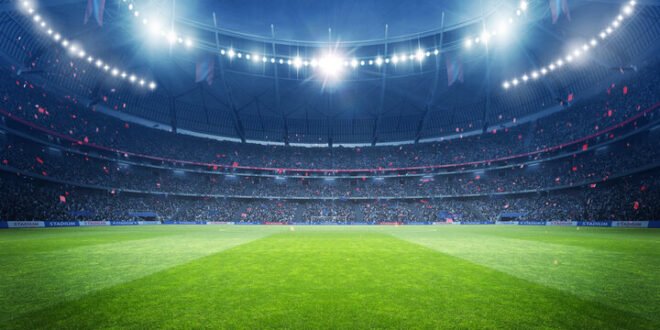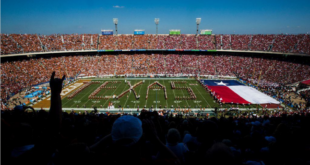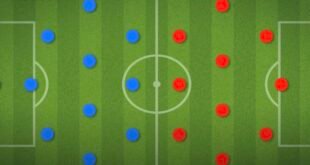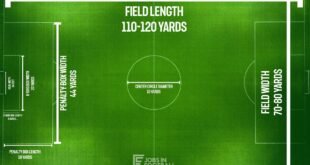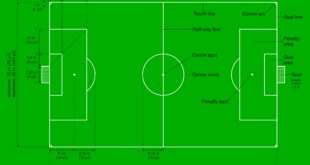A soccer field background sets the stage for the sport’s action. It consists of a grassy or artificial turf surface marked for play.
Soccer, known globally as football, is played on a rectangular field that is fundamental to the game. The field, or pitch, is where all the strategies, skills, and thrills of soccer unfold. It must meet certain dimensions: typically 90-120 meters in length and 45-90 meters in width, ensuring ample space for continuous play.
The field’s green expanse, whether natural or synthetic, is iconic, bordered by white lines that define the playing area and goal boxes. Each half of the pitch mirrors the other, with a center circle, penalty areas, and spots that govern where the ball is placed during specific situations. This carefully designed surface is not just about aesthetics; it provides a standardized canvas for teams worldwide to showcase their prowess in the beautiful game. Soccer Field Background Perfectly aligned goals beckon players at each end, promising excitement for fans and athletes alike.
The Origin Of The Soccer Field
Table of Contents
Imagine a game of soccer without a field. What would it be like? Soccer fields, also known as pitches, are central to the game we love. But where did they come from? Let’s dive into the origin of the soccer field and understand how a simple patch of grass evolved to become the heart of the most popular sport in the world.
Early History And Development
The first soccer fields were far from uniform. Back then, towns played on open land. The rules varied, as did the field sizes. Fields didn’t have the clear boundaries we see today. There’s evidence that markers like trees or town landmarks acted as goals. Many believe early soccer games took place in entire villages! The goal was simple: get the ball to the opponent’s mark, no matter the distance.
- Medieval origins: Soccer-like games date back to medieval times.
- Lack of standardization: Each game had its unique ‘field’ drawn using natural landmarks.
- Community involvement: Entire villages joined these chaotic and vast matches.
Evolution Of Field Design
The design of soccer fields has undergone significant changes over time. Eventually, England’s Football Association came into play and standardized the field size and layout. Thanks to the FA, we got rectangular fields with specific dimensions and painted lines.
| Year | Event | Impact on Field Design |
|---|---|---|
| 1863 | Formation of the Football Association (FA) | Standardized the size and shape of soccer fields |
| 1875 | Introduction of the crossbar | Replaced tape as the goal’s upper limit |
| 1882 | Penalty kick introduced | Defined the penalty area and spot |
Over time, lines were painted to mark the boundaries and goal areas. Positions, strategies, and even rules could now be more specific and complex, thanks to a unified playing space.
- Rectangular shape becomes the standard.
- Goal and boundary lines are marked clearly.
- Consistent pitch sizes across the world.

Anatomy Of A Modern Soccer Field
Welcome to the vibrant world of soccer! Understanding the design of a soccer field helps players and fans alike. Peek into the features that make it more than just a patch of grass!
Field Dimensions And Markings
A standard soccer field’s length ranges from 100 to 110 meters. The width must be between 64 and 75 meters. Each line on the turf plays a role. The touchlines define the long sides while the goal lines mark the ends.
- The center circle is where kickoffs occur.
- Penalty areas are crucial for game-changing moments.
The halfway line splits the field. It aligns with the exact center.
Grass Types And Turf Management
The grass type contributes to the game’s pace. Fields use either natural grass or artificial turf. Professional soccer typically demands natural grass. Groundskeepers maintain their quality year-round. Here’s how:
- Regular mowing ensures an even playing surface.
- Irrigation systems keep the turf hydrated.
For maintenance ease, some opt for artificial turf. It withstands various weather conditions.
Goalposts And Net Specifications
Every soccer field has two goalposts. They sit opposite each other on the goal lines. Standard dimensions are important:
| Part of Goal | Specification |
|---|---|
| Width | 7.32 meters |
| Height | 2.44 meters |
| Depth | Up to 5 feet |
Goals use nets to catch the soccer ball. This prevents disputes about scoring. They must be properly attached and free of holes.
Global Standards And Variations
The beautiful game of soccer is known for its universal appeal. Despite this, the fields where the magic happens can vary widely. Differing standards and modifications touch every corner of the globe. Understanding these nuances is vital for players, fans, and sports professionals alike.
Fifa Regulations
Under FIFA’s watchful eye, the game maintains certain standards. The FIFA rulebook outlines specific dimensions for international play.
| Field Component | Standard Measurements |
|---|---|
| Length | 100m – 110m |
| Width | 64m – 75m |
| Goal Area | 5.5m from each goalpost |
| Penalty Area | 16.5m from each goalpost |
| Goal Size | 2.44m in height, 7.32m in width |
Differences In Amateur And Professional Fields
Not all fields meet FIFA’s precise criteria. Smaller budgets and space constraints mean amateur fields often differ.
- Size: Amateur fields may be smaller.
- Markings: Lines could be faded or inaccurate.
- Goal posts: Sometimes smaller or makeshift.
- Turf: Grass quality can range widely.
Although professional fields showcase pristine grass and precise markings, amateur pitches display a charming variety. This diversity enriches soccer, making it accessible to everyone.
The Field As A Strategic Element
In soccer, the field is not just green turf; it’s a battleground where strategies unfold. Different field dimensions, surface types, and conditions impact the game. A team’s familiarity with their home field and the ability to adapt to various environmental factors can tip the scales in their favor. Let’s explore how.
Home Advantage And Field Familiarity
Home teams often perform better on their familiar pitch. Knowing every angle, and every patch of grass can be crucial. This advantage is multi-layered:
- Size of the field: Smaller or larger fields benefit different styles of play.
- Surface: Grass quality can affect ball speed and player movement.
- Stadium layout: Proximity of fans can boost home team morale.
Teams practice on their home field, giving them a unique comfort level. This intimacy with their environment translates into strategic movements and plays that can catch opponents off guard.
Weather And Environmental Impacts On Play
Climatic conditions have a significant impact on soccer. Games can hinge on how well teams adjust to these elements:
| Weather Condition | Impact on Game |
|---|---|
| Rain | A slippery surface affects ball control. |
| Wind | Alters ball trajectory complicates long passes. |
| Heat | Player fatigue may slow down the game tempo. |
| Snow | Visibility issues, changes in ball movement. |
Not only the weather but also altitude and field orientation towards the sun can disrupt a team’s performance. Successful teams prepare for these variables, adjusting their play to maintain control over the game under any circumstances.
Soccer Field Maintenance And Upkeep
A well-kept soccer field is vital for the flow of the game.
Regular maintenance ensures a safe and enjoyable experience for players and spectators.
Let’s explore the best practices and innovative solutions that keep soccer fields in top shape.
Routine Care Practices
Effective soccer field maintenance starts with daily and weekly routines.
These ensure turf health and field playability.
- Mowing: Keep grass at ideal height.
- Aeration: Reduces soil compaction.
- Overseeding: Fills in bare spots.
- Fertilization: Nourishes the turf.
- Watering: Keeps the grass hydrated.
- Marking lines: Keep them visible.
Each step is crucial for a resilient and healthy field.
Professionals often follow a schedule to cover all aspects thoroughly.
Innovations In Field Maintenance Technology
Technology advances bring new tools for field care.
They simplify maintenance and improve accuracy.
| Tool | Function | Benefit |
|---|---|---|
| Robotic Mowers | Automated cutting | Consistent grass height |
| GPS Line Markers | Precision marking | Reduced paint waste |
| Soil Sensors | Moisture monitoring | Optimized watering |
Adopting these tools can dramatically reduce labor costs and enhance the field’s quality.

Cultural Significance Of Soccer Fields
Soccer fields are more than just patches of grass for playing sports. They are vital hubs where cultures merge, communities bond, and history unfolds. In every kick and cheer, they carry distinct narratives that resonate with millions globally.
Fields As Community Gathering Spots
Soccer fields serve as the heart of communities. They witness local festivals, social events, and even moments of collective mourning. The game unites people, transcending age, background, and social status. In these fields, friendships form and life lessons take shape through the simple act of play.
Iconic Soccer Stadiums Around The World
Iconic stadiums stand as landmarks, encapsulating the spirit of the places they inhabit. They are architectural marvels, often reflecting the passion and identity of a nation. Here’s a look at some of the most revered soccer stadiums:
- Wembley Stadium in London – Nicknamed “The Home of Football,” it has hosted numerous historic matches.
- Maracanã Stadium in Rio de Janeiro – A symbol of Brazil’s soccer fervor, it has seen some of the most memorable matches ever played.
- Camp Nou in Barcelona – Home to FC Barcelona, it resonates with the motto ‘More than a club’, reflecting its role in Catalan culture.
- Santiago Bernabéu in Madrid – Hosting Real Madrid’s matches, it’s a testament to the club’s storied history and success.
Each stadium tells a unique story, echoing the chants and dreams of countless individuals.
Advancements In Soccer Field Technology
The world of soccer is not just about talent and skill. The field itself plays a crucial role. Recent technological advancements have transformed how the sport is played and enjoyed. Soccer fields have evolved from simple grass pitches to high-tech surfaces that enhance the game’s safety, pace, and overall experience.
Choosing the right surface for a soccer field impacts the game massively. Let’s compare two popular options:
Artificial Turf Advantages
- Durable and can withstand heavy use.
- Consistent playing conditions regardless of weather.
- Requires less water and maintenance.
Natural Grass Benefits
- Offers a soft natural surface that can prevent injuries.
- Preferred by many players for its authentic feel.
- Eco-friendly, as it helps in carbon reduction.
Technology is taking soccer fields to the next level:
Smart Fields
- Integrated sensors measure soil moisture and quality.
- Help in optimizing maintenance and field conditions.
- LED lighting systems adjust to reduce shadows and glare.
Player Tracking Systems
- Wearable tech and field sensors monitor player performance.
- Data analysis tools give insights into speed, distance, and health.
- Coaches use this information to tailor training and reduce injuries.
Soccer fields have indeed come a long way. They are smarter, more efficient, and tailor-made to enrich the sport’s quality. As the game continues to grow, so will the technology that nurtures it.

The Future Of Soccer Field Design
As we gaze into the future, soccer field design stands at the cusp of innovation.
Bold moves towards sustainability and enhanced fan experiences are shaping new arenas.
Eco-friendly And Sustainable Practices
Green strategies are at the heart of modern soccer field design.
- Water conservation systems reuse rainwater for pitch irrigation.
- Fields are increasingly using eco-friendly construction materials.
- Solar panels power stadium facilities, cutting down electricity use.
By integrating nature into designs, fields become one with their environment.
Next-generation Stadiums And Fan Experience
Stadiums of the future aim to amplify fan enjoyment.
| Feature | Benefits |
|---|---|
| Interactive seats | Customize viewing angles and engage with instant replays. |
| VR zones | Experience the game in a virtual reality setting. |
| Mobile apps | Place orders for food and merchandise from your seat. |
New technologies provide immersive experiences and bring fans closer to the action.
Frequently Asked Questions For Soccer Field Background
What are standard soccer field dimensions?
Soccer fields, or pitches, can vary in size. Professional field dimensions are typically 100 to 130 yards long and 50 to 100 yards wide. FIFA regulations suggest a range of 110-120 yards by 70-80 yards for international matches.
Can soccer fields have artificial turf?
Yes, artificial turf is allowed for soccer fields, especially at amateur levels and in locations where grass maintenance is challenging. FIFA’s Quality Programme for Football Turf sets standards for artificial surfaces to ensure safety and quality.
How To maintain a soccer field?
Maintaining a soccer field involves regular mowing, watering, fertilizing, and aerating to promote healthy grass. Also, repairing goal areas, repainting field markings, and inspecting for safety hazards are key to keeping the field in top condition.
What is the soccer field grass type?
Soccer fields commonly use cool-season grasses such as Kentucky bluegrass, perennial ryegrass, and fescues. In warmer climates, Bermuda grass is preferred for its durability and ability to withstand heavy usage.
Conclusion
Exploring the soccer field’s background enriches our appreciation for the beautiful game. It’s not just about the players or the rules, but the canvas they play on—each with its own story. Whether you’re a die-hard fan or a curious onlooker, remember that every pitch holds the heart of soccer within its lines and contours.
 Cric Enjoy Sports News, Cricket Update, Live Streaming
Cric Enjoy Sports News, Cricket Update, Live Streaming
